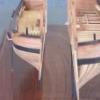-
Posts
3,084 -
Joined
-
Last visited
Reputation Activity
-
 Jaager got a reaction from Canute in extra partial (top timber) frame
Jaager got a reaction from Canute in extra partial (top timber) frame
My guess is: filler top .
In any case, what you show is a nightmare. Tapered timbers - shifted timbers. re-enforces my preference for planking everything from the main wale on up. In which case, it is easier and makes for a more stable hull to fill the spaces above the main wale with timbers.
-
 Jaager got a reaction from mtaylor in extra partial (top timber) frame
Jaager got a reaction from mtaylor in extra partial (top timber) frame
My guess is: filler top .
In any case, what you show is a nightmare. Tapered timbers - shifted timbers. re-enforces my preference for planking everything from the main wale on up. In which case, it is easier and makes for a more stable hull to fill the spaces above the main wale with timbers.
-
 Jaager got a reaction from mtaylor in Build Deck Separately
Jaager got a reaction from mtaylor in Build Deck Separately
Rather than settling for Denken Experimenten ( thought experiment ) do the real thing. Basswood is available for low cost. Joann, Michaels, even Walmart seems to have sheets in several thicknesses, so if the experiment fails, you will only be out of some time, time that will have increased your skills at worst. Use the 3rd party stock. I know one and done is appealing, but if you get into scratch building, you will wind up having to redo a lot. The redo time will be less than the time taken by the nagging memory that continues to occur if you do something wrong and let it go.
Another suggestion: place your simulated deck beams on either side of the moulds/bulkheads. No play when you assemble it on the hull and you do not need to be precise in how much of the center spine you cut away. It just needs to be enough to clear your beams.
-
 Jaager got a reaction from Canute in Build Deck Separately
Jaager got a reaction from Canute in Build Deck Separately
Rather than settling for Denken Experimenten ( thought experiment ) do the real thing. Basswood is available for low cost. Joann, Michaels, even Walmart seems to have sheets in several thicknesses, so if the experiment fails, you will only be out of some time, time that will have increased your skills at worst. Use the 3rd party stock. I know one and done is appealing, but if you get into scratch building, you will wind up having to redo a lot. The redo time will be less than the time taken by the nagging memory that continues to occur if you do something wrong and let it go.
Another suggestion: place your simulated deck beams on either side of the moulds/bulkheads. No play when you assemble it on the hull and you do not need to be precise in how much of the center spine you cut away. It just needs to be enough to clear your beams.
-
 Jaager got a reaction from reklein in How Do You Drive Those Tiny Nails?
Jaager got a reaction from reklein in How Do You Drive Those Tiny Nails?
Maybe you should start low tech =
The middle one works best for me.
The wood is usually thin enough that hand drilling goes quickly.
You need bits:
This one is convenient. When you break a bit, replacements come per gauge - usually in packs of 6-10.
If you know the gauge for the brass nail, having backups is good.
This is a handy tool =
This one along with this:
I use as my draw plates to make trunnels from bamboo skewers - end caps in most grocery stores.
-
 Jaager got a reaction from Julie Mo in How Do You Drive Those Tiny Nails?
Jaager got a reaction from Julie Mo in How Do You Drive Those Tiny Nails?
Maybe you should start low tech =
The middle one works best for me.
The wood is usually thin enough that hand drilling goes quickly.
You need bits:
This one is convenient. When you break a bit, replacements come per gauge - usually in packs of 6-10.
If you know the gauge for the brass nail, having backups is good.
This is a handy tool =
This one along with this:
I use as my draw plates to make trunnels from bamboo skewers - end caps in most grocery stores.
-
 Jaager got a reaction from mtaylor in Second Planking
Jaager got a reaction from mtaylor in Second Planking
Chuck,
I suspect a lot of your problem is the species of wood. Walnut - even Black Walnut - Juglans nigra - which I serious doubt is the species you have is open pore - and the species used in Europe ( European/African sourced) look even more open grain and brittle.
You may consider using another species of wood. There are vendors here who can supply veneer that will play nice. You can dye a light colored wood if Walnut is the shade you want. You an get wider pieces and do a proper job of spilling ( der. "spoilling" - it means cutting away a lot of perfectly good wood to get a plank it fit the hull curves properly.
If nothing else - and you are local - Woodcraft - has veneer - you want the sort that is not expensive anyway - the high cost burl/figured material are the characteristics that you do not want - they do not translate well in the 1:50- 1:100 scale range. Checking their catalog - the following are examples of what you may consider:
Cherry Veneer 3 sq ft pack 9.99, 12 sq ft pack 21.50
Beech Veneer 3 sq ft pack 10.99
Maple Veneer 3 sq ft pack 10.19 , 12 sq ft pack 20.99
Maple and Beech will dye darker - so will Cherry, but why guild a lilly?
-
 Jaager got a reaction from Jack12477 in How Do You Drive Those Tiny Nails?
Jaager got a reaction from Jack12477 in How Do You Drive Those Tiny Nails?
Maybe you should start low tech =
The middle one works best for me.
The wood is usually thin enough that hand drilling goes quickly.
You need bits:
This one is convenient. When you break a bit, replacements come per gauge - usually in packs of 6-10.
If you know the gauge for the brass nail, having backups is good.
This is a handy tool =
This one along with this:
I use as my draw plates to make trunnels from bamboo skewers - end caps in most grocery stores.
-
 Jaager got a reaction from robnbill in How Do You Drive Those Tiny Nails?
Jaager got a reaction from robnbill in How Do You Drive Those Tiny Nails?
Maybe you should start low tech =
The middle one works best for me.
The wood is usually thin enough that hand drilling goes quickly.
You need bits:
This one is convenient. When you break a bit, replacements come per gauge - usually in packs of 6-10.
If you know the gauge for the brass nail, having backups is good.
This is a handy tool =
This one along with this:
I use as my draw plates to make trunnels from bamboo skewers - end caps in most grocery stores.
-
 Jaager got a reaction from Canute in Second Planking
Jaager got a reaction from Canute in Second Planking
Chuck,
I suspect a lot of your problem is the species of wood. Walnut - even Black Walnut - Juglans nigra - which I serious doubt is the species you have is open pore - and the species used in Europe ( European/African sourced) look even more open grain and brittle.
You may consider using another species of wood. There are vendors here who can supply veneer that will play nice. You can dye a light colored wood if Walnut is the shade you want. You an get wider pieces and do a proper job of spilling ( der. "spoilling" - it means cutting away a lot of perfectly good wood to get a plank it fit the hull curves properly.
If nothing else - and you are local - Woodcraft - has veneer - you want the sort that is not expensive anyway - the high cost burl/figured material are the characteristics that you do not want - they do not translate well in the 1:50- 1:100 scale range. Checking their catalog - the following are examples of what you may consider:
Cherry Veneer 3 sq ft pack 9.99, 12 sq ft pack 21.50
Beech Veneer 3 sq ft pack 10.99
Maple Veneer 3 sq ft pack 10.19 , 12 sq ft pack 20.99
Maple and Beech will dye darker - so will Cherry, but why guild a lilly?
-
 Jaager got a reaction from Canute in How Do You Drive Those Tiny Nails?
Jaager got a reaction from Canute in How Do You Drive Those Tiny Nails?
Maybe you should start low tech =
The middle one works best for me.
The wood is usually thin enough that hand drilling goes quickly.
You need bits:
This one is convenient. When you break a bit, replacements come per gauge - usually in packs of 6-10.
If you know the gauge for the brass nail, having backups is good.
This is a handy tool =
This one along with this:
I use as my draw plates to make trunnels from bamboo skewers - end caps in most grocery stores.
-
 Jaager got a reaction from mischief in CA for rigging
Jaager got a reaction from mischief in CA for rigging
I have a suggestion:
First, why:
Rigging is totally exposed to the atmosphere. This planet is enveloped in a layer of a highly reactive ( and looked at objectively - a very poisonous ) gas = Oxygen. You can readily see it effects on iron - almost as you watch. An acidic pH only enhances its reactivity.
CA probably oxidizes - it likely continues the chemical reaction that produces its function ( it needs water - which is certainly present in the atmosphere ). The polymerization can continue until near complete - producing a material that is brittle.
Titebond II - yellow PVA - has is pH 3. This is 10,000 x's more acidic than freshly distilled water.
Weldbond - white PVA - has is pH 5.5. This is about the same as normal water - which is actually a dilute solution of carbonic acid ( atmospheric CO2 disolved in water).
I suggest using something like Lineco White Neutral pH Adhesive. It is a PVA used by bookbinders and preservationists. Dries clear and can be diluted in water to soak into natural cellulose fiber rigging. It does not do do well with plastic, so if you rig with nylon or other synthetic products, use another material.
One property of plastic rigging material: they are formed thru a chemical reaction = polymerization. long chain molecules are bonded to short ones - producing a web or mesh. If there is enough linking, a strong flexible material is produced. If there is too much cross linking, a rigid, brittle and weak material. In the presence of UV light, oxygen and heat - plastics continue to cross link on their own. The material will ultimately shatter.
Linen, on the other hand - I believe they are finding 3-5 thousand year old mummies still wrapped in functional linen fabric.
-
 Jaager got a reaction from Canute in sealing solid hull
Jaager got a reaction from Canute in sealing solid hull
If it is intended to adhere to glass,then poly will provide a plastic surface that is about as close to glass as can be had. You probably want to give the surface a good rubdown wit 0000 steel wool, before, between and after each coat. Vacuum and tack rag the dust and steel fragments throughly after each treatment. Any steel left can rust and stain. 600 grit Silicon carbide paper may be a good alternative to steel wool.
-
 Jaager got a reaction from Canute in sealing solid hull
Jaager got a reaction from Canute in sealing solid hull
Having had bond failure between Weldwood contact cement and flame treated copper plates - a method in the 1970's Model Shipways catalog - investigate the best conditions for bonding with your chosen adhesive and use that to determine what treatment to give the hull.
It has been a very long time since I saw the brig Eagle hull, but as I remember, the cement under the failed plates was copper colored, making it difficult to tell they were missing. I suspect the heating process produced a micro layer of a copper oxide that was not compatible with Weldwood. I also use it to attach cloth backed sanding medium to the platten of my thickness sander. A heat gun makes for easy removal of the spent sanding medium. I suspect that Weldwood is medium time frame adhesive.
My present thinking on coppering is to use a high quality archival smooth surface paper painted with copper and verdigris shades and use PVA to attach it to a raw wood hull.
-
 Jaager got a reaction from mtaylor in sealing solid hull
Jaager got a reaction from mtaylor in sealing solid hull
Having had bond failure between Weldwood contact cement and flame treated copper plates - a method in the 1970's Model Shipways catalog - investigate the best conditions for bonding with your chosen adhesive and use that to determine what treatment to give the hull.
It has been a very long time since I saw the brig Eagle hull, but as I remember, the cement under the failed plates was copper colored, making it difficult to tell they were missing. I suspect the heating process produced a micro layer of a copper oxide that was not compatible with Weldwood. I also use it to attach cloth backed sanding medium to the platten of my thickness sander. A heat gun makes for easy removal of the spent sanding medium. I suspect that Weldwood is medium time frame adhesive.
My present thinking on coppering is to use a high quality archival smooth surface paper painted with copper and verdigris shades and use PVA to attach it to a raw wood hull.
-
 Jaager got a reaction from mtaylor in sealing solid hull
Jaager got a reaction from mtaylor in sealing solid hull
If it is intended to adhere to glass,then poly will provide a plastic surface that is about as close to glass as can be had. You probably want to give the surface a good rubdown wit 0000 steel wool, before, between and after each coat. Vacuum and tack rag the dust and steel fragments throughly after each treatment. Any steel left can rust and stain. 600 grit Silicon carbide paper may be a good alternative to steel wool.
-
 Jaager got a reaction from lionfish in sealing solid hull
Jaager got a reaction from lionfish in sealing solid hull
If it is intended to adhere to glass,then poly will provide a plastic surface that is about as close to glass as can be had. You probably want to give the surface a good rubdown wit 0000 steel wool, before, between and after each coat. Vacuum and tack rag the dust and steel fragments throughly after each treatment. Any steel left can rust and stain. 600 grit Silicon carbide paper may be a good alternative to steel wool.
-
 Jaager got a reaction from Seventynet in sealing solid hull
Jaager got a reaction from Seventynet in sealing solid hull
If it is intended to adhere to glass,then poly will provide a plastic surface that is about as close to glass as can be had. You probably want to give the surface a good rubdown wit 0000 steel wool, before, between and after each coat. Vacuum and tack rag the dust and steel fragments throughly after each treatment. Any steel left can rust and stain. 600 grit Silicon carbide paper may be a good alternative to steel wool.
-
 Jaager got a reaction from Canute in Top Railing 90 deg. Joints-What type of Joint is used?
Jaager got a reaction from Canute in Top Railing 90 deg. Joints-What type of Joint is used?
My first thought was snarky- especially for the English shipwrights: Why do a simple butt joint when you can do a scarph?
Then thinking about it - the structure is subject to constant motion and stress in all 4 dimensions - though the effect of Time is much more gradual. A straight butt joint would be difficult to fasten in a way that was not subject to early failure.
Quick research answer: Not a butt joint or a scarph - a third element : a lateral knee was worked in. It spanned about 1/2 the width of the rail timbers, each arm would be long enough to support a couple of horizontal trunnels into each rail segment and the inner surface would be an arc rather than an abrupt meeting of two planes.
-
 Jaager got a reaction from mtaylor in Top Railing 90 deg. Joints-What type of Joint is used?
Jaager got a reaction from mtaylor in Top Railing 90 deg. Joints-What type of Joint is used?
My first thought was snarky- especially for the English shipwrights: Why do a simple butt joint when you can do a scarph?
Then thinking about it - the structure is subject to constant motion and stress in all 4 dimensions - though the effect of Time is much more gradual. A straight butt joint would be difficult to fasten in a way that was not subject to early failure.
Quick research answer: Not a butt joint or a scarph - a third element : a lateral knee was worked in. It spanned about 1/2 the width of the rail timbers, each arm would be long enough to support a couple of horizontal trunnels into each rail segment and the inner surface would be an arc rather than an abrupt meeting of two planes.
-
 Jaager got a reaction from dgbot in Top Railing 90 deg. Joints-What type of Joint is used?
Jaager got a reaction from dgbot in Top Railing 90 deg. Joints-What type of Joint is used?
My first thought was snarky- especially for the English shipwrights: Why do a simple butt joint when you can do a scarph?
Then thinking about it - the structure is subject to constant motion and stress in all 4 dimensions - though the effect of Time is much more gradual. A straight butt joint would be difficult to fasten in a way that was not subject to early failure.
Quick research answer: Not a butt joint or a scarph - a third element : a lateral knee was worked in. It spanned about 1/2 the width of the rail timbers, each arm would be long enough to support a couple of horizontal trunnels into each rail segment and the inner surface would be an arc rather than an abrupt meeting of two planes.
-
 Jaager got a reaction from mtaylor in Small Lathe
Jaager got a reaction from mtaylor in Small Lathe
For ways and static surfaces, I am now using Renaissance Wax. For the threads and general lubrication, I used to use light machine oil. I had a quart from Sears that I used up. I could find nothing like it on line. I guess I do not know the correct name for it, I use mineral oil from the laxative section of a pharmacy for lubrication now. No problems so far. Used to be light and heavy Mineral oil available, now all I find is plain mineral oil.
Using a Scotch Brite Pad with WD40 works a champ to remove rust before rubbing down with the wax.
-
 Jaager got a reaction from Canute in Bass/Lime wood for a fully framed model?
Jaager got a reaction from Canute in Bass/Lime wood for a fully framed model?
To you guys in the UK :
There is a hardwood that should be readily available - Sycamore maple Acer pseudoplatanus
It is very similar to our Hard maple (sugar / rock ).
It was a species favored by Underhill.
Because of the difference in local vernacular, I got a supply of Sycamore from a sawmill in Eastern Kentucky. Alas, Sycamore here is a different species in another genus Platanus occidentalis. For our purposes, pseudo platanus is better than actual platanus.
Our version is less dense, is a lot more brittle - more readily splits - gets fuzzy. It is also sold as lacewood because of it's ray flecks - which at scale - presents something that looks like nothing in nature.
Looking at lumber prices in the UK - from what I can see - the prices are outrageous - they really see you guys coming. If you have local furniture makers, I would visit and see where they get their lumber - they may even have cutoffs or surplus you could get a deal on.
-
 Jaager got a reaction from mtaylor in Bass/Lime wood for a fully framed model?
Jaager got a reaction from mtaylor in Bass/Lime wood for a fully framed model?
To you guys in the UK :
There is a hardwood that should be readily available - Sycamore maple Acer pseudoplatanus
It is very similar to our Hard maple (sugar / rock ).
It was a species favored by Underhill.
Because of the difference in local vernacular, I got a supply of Sycamore from a sawmill in Eastern Kentucky. Alas, Sycamore here is a different species in another genus Platanus occidentalis. For our purposes, pseudo platanus is better than actual platanus.
Our version is less dense, is a lot more brittle - more readily splits - gets fuzzy. It is also sold as lacewood because of it's ray flecks - which at scale - presents something that looks like nothing in nature.
Looking at lumber prices in the UK - from what I can see - the prices are outrageous - they really see you guys coming. If you have local furniture makers, I would visit and see where they get their lumber - they may even have cutoffs or surplus you could get a deal on.
-
 Jaager got a reaction from mtaylor in Gunports
Jaager got a reaction from mtaylor in Gunports
You are your own shipwright, if you wish to mount a plasma pulse cannon on the deck, you are free to do it. Anachronisms and additions without reasonable documentation tends to drive those with a historian tendency berserk. No matter as long as you are honest about what your model really represents. It would not pass muster in a competition, most likely.










